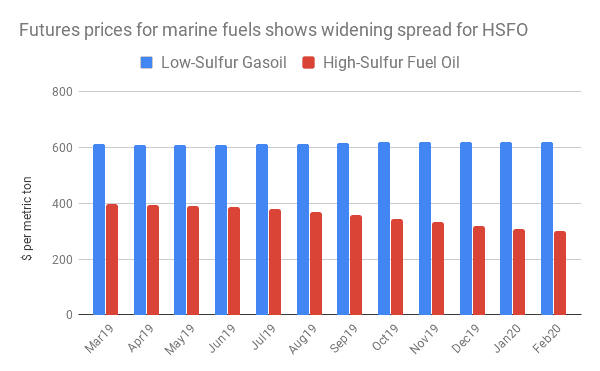Largest ocean freight forwarder sees fuel bills increasing as much as 50 percent based on current price spreads.
Kuehne + Nagel (SIX: KNIN) (K +N), forecasts that the fuel bills for the world’s container ship fleets will rise as much as 50 percent with the start of new rules on the sulfur content of marine fuel. But with nearly half of its business coming from ocean freight, the Swiss freight forwarder is looking at how it can stem those costs for its customers.
K + N outlined the risks facing ocean shippers in a whitepaper to customers. This comes 10 months ahead of the mandate (known as IMO 2020) from the United Nations’ International Maritime Organization that all commercial vessels use a fuel containing no more than 0.5 percent sulfur, down from the 3.5 percent currently used on open seas.
The prospect of a wholesale switch to a new fuel is reverberating up and down marine supply chains. Ships consume about three million barrels per day of high-sulfur fuel oil. But the switch will not be easy as refineries have only made limited commitments to producing the new marine fuel. Indeed, K + N warned that still developing standards for IMO 2020 marine fuel means “transportation services may be disrupted as a result of inadequate fuel quality, which may lead to engine failures or insufficient availability of compliant bunker fuel.”
The result is “a high level of uncertainty about availability of petroleum products and pricing,” K + N said. “At this stage all we can predict is that it will cost more than currently available fuels.”
Still, K + N does try to predict those cost impacts.
With low-sulfur fuel priced around $600 per metric ton, K + N said a container ship sailing from Asia to Europe faces a $3.76 million fuel bill, up from $2.5 million with high-sulfur fuel. A container ship on the trans-Pacific trade could see a $1.34 million fuel bill, up from just around $900,000 now.

K + N assumes that fuel prices add another $180 to $400 per twenty-foot equivalent (TEU) to shipping costs. Those increases would add about 20 percent to 40 percent to current spot rates for container shipping according to the Freightos Baltic Index available on SONAR (SONAR: FBX).

As ocean carriers will pass on those higher variable costs, K + N said it is looking to offer ocean freight with fixed fuel prices, rather than subject shippers to the many different surcharge schemes ocean carriers are bandying about. Although K + N has not said how it will fix fuel prices, it may likely involve some use of new futures contracts that offer a hedge against IMO 2020.
Of course, ocean carriers and their customers are looking at ways to mitigate the price increases. One way is to install exhaust gas scrubbers, which remove sulfur from regular marine fuel. Mediterranean Shipping Company (MSC) is betting on that technology with 86 of its 500 ships to be fitted with scrubbers. Liquefied natural gas (LNG) also promises to meet the low-sulfur threshold. CMA CGM made the biggest move in that space with nine ultra-large container ships to be fueled with LNG set to arrive by 2020.
But both alternatives carry risks. Ships are facing scrubber bans in some port cities due to concerns about the discharge of sulfur into the ocean. LNG, meanwhile, faces the hurdle of a lack of global availability due to limited infrastructure.
Marine fuel expert disses worth of scrubber bans
Bunker fuels expert says port state bans on sulfur scrubbers not meaningful. (Ship & Bunker)
Port of Tampa Bay gets direct service to Vietnam
CMA CGM’s Pacific Express will run starting in May 2019. (Tampa Bay Business Journal)
WTO does not like word trade outlook
Trade watchdog sees indices at lowest levels in years. (Maritime Executive)
Panama flag state report throws doubt on scrubbers
MIT researchers said to be doubtful of sulfur removal with devices. (Lloyd’s List)
U.S. ports get funding, but still more needed
The consolidated appropriations bill that President Donald Trump and Congress agreed to not only turned the lights back on for the U.S. government, but also contained the first ever funding dedicated to port infrastructure, FreightWaves John Gallagher reports. The bill appropriates $300 million for port infrastructure, with the nation’s 15 largest ports to get just under one-third of that amount. The industry’s main trade group, the American Association of Port Authorities, noted that ports “fared well” in the new budget. But it noted that U.S. ports could do with closer to $66 billion in spending over the next decade to better improve access to the nation’s rail and road networks.
Pull forward powers up Expeditors earnings
Freight forwarder Expeditors International (Nasdaq: EXPD) reported fourth quarter earnings that were well above consensus estimates, thanks to a lower tax rate, but also with better operating earnings. Expeditors’ main market is servicing the trans-Pacific trade between U.S. and Asia, writes FreightWaves Mark Solomon, and with the year of tariff scares and strong consumer spending, the trade was strong. Ocean freight revenue was up 18 percent in the fourth quarter, a strong acceleration from the third quarter’s 4 percent growth, as shippers raced to get product into the U.S. Ocean revenues accelerated even faster than rates which were up 10 percent during the quarter.







